Basic information about the power forward in basketball
General definition of power forward
The power forward is one of the five common basketball positions that is mainly responsible for rebounding as well as scoring points and playing defense near the basket or near the perimeter areas of the court.
Also, the power forward is generally indicated as the number 4 and the usual abbreviation is denoted as PF.
The basketball diagrams below show basic offensive and defensive examples of the power forward alongside the other standard positions in half court settings.
Example of power forward and other player positions on offense
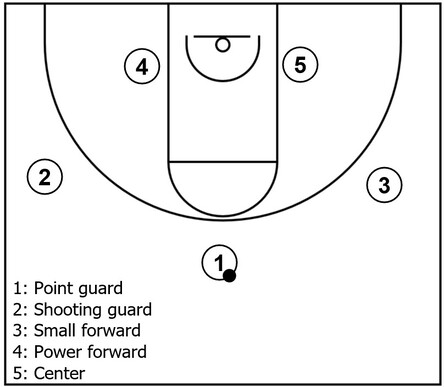
This is an example of the power forward and other standard basketball positions during offensive execution.
As mentioned before, the power forward is represented by the number 4 alongside other players who also have respective numbers.
That is to say: 1 is the offensive point guard; 2 is the offensive shooting guard; 3 is the offensive small forward; 5 is the offensive center.
Additionally, for the setup: 1 is at the top while in possession of the ball, represented by the black dot; 2 and 3 occupy the wings; 4 and 5 fill the low post areas.
Furthermore, this is also a 3 out 2 in alignment as there are three players outside of the three-point line and two players inside of that same line.
Example of power forward and other player positions on defense
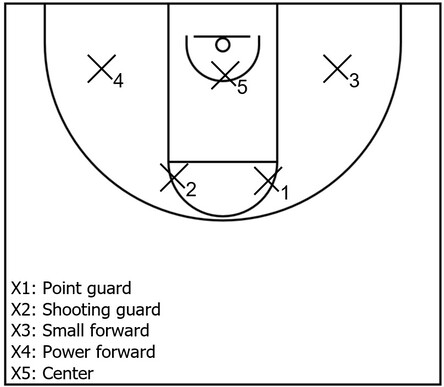
This is an example of the power forward and other players on defense. For this case, the players are executing a type of defensive strategy known as a 2-3 zone defense.
Moreover, the power forward, who is in the back of the zone, is denoted with the letter X followed by the number 4.
In other words, the letter X on a basketball diagram generally signifies a defensive player while a number next to that letter typically represents that player’s position.
This applies to the other players as well. That is to say: X1 is the defensive point guard; X2 is the defensive shooting guard; X3 is the defensive small forward; X5 is the defensive center.
Common skills of the power forward
Rebounding
The power forward is usually adept at gathering defensive boards but could also be an adequate rebounder on the offensive side of the ball as well.
In essence, the power forward can collect rebounds, mainly by using their overall size, particularly their height and arm length, to box out their respective assignment during man to man defense or the nearest offensive player in a zone defense coverage.
Screening
During offensive execution, the power forward is typically one of the team’s best players in terms of setting good on-ball screens as well as off-ball screens.
In this instance, the power forward can use their size and strength to hinder or totally block the movement of opposing defenders.
That, in turn, can free up teammates who would be able to receive the basketball to score or make plays for others, including the power forward.
Passing
The power forward is generally able to perform a variety of passes including but not necessarily limited to the most common ones such as the basic chest pass, bounce pass, or overhead pass.
The power forward is also typically capable of performing other types of passes that are generally more advanced beyond the common ones such as the skip pass, baseball pass, or outlet pass.
These particular passing abilities can possibly lead to scoring opportunities for other teammates as well as a decent amount of assists for the power forward.
Examples of possible offensive actions that could involve the power forward
This section contains examples of possible offensive actions that could involve the power forward in some manner.
These offensive actions could also potentially lead to scoring opportunities for the power forward or other teammates.
Back screen
The back screen could be set by the power forward directly behind a defender and after that, a teammate could use that screen to get open near the basket.
The power forward would typically set the back screen near the high post area or near the wing.
The following diagram demonstrates this action.
Example of power forward setting back screen for teammate
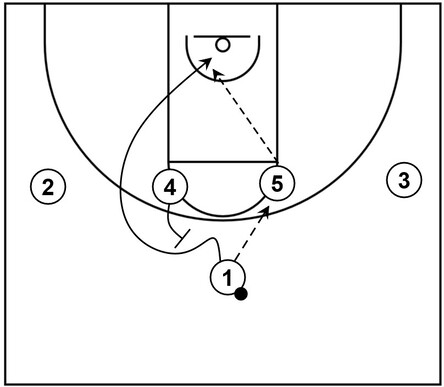
This example from a 1-4 high set consists of a power forward setting a back screen to help a teammate get open for a possible scoring opportunity.
To begin the simple action, 5 receives the ball from 1 who then cuts to the basket by way of a back screen set by 4, which is also indicated by the T-like symbol.
Afterwards, 1 could receive the ball again from 5, assuming that is open, and score via a layup at the basket.
Cross screen
The power forward could use a cross screen that is initially set by a teammate within the lane near the basket or near the high post area.
From there, the power forward could get open, gain possession of the ball, and score via a layup, low post move, or perhaps even a mid-range jump shot.
The following diagram showcases an example of the cross screen action.
Example of power forward using a cross screen
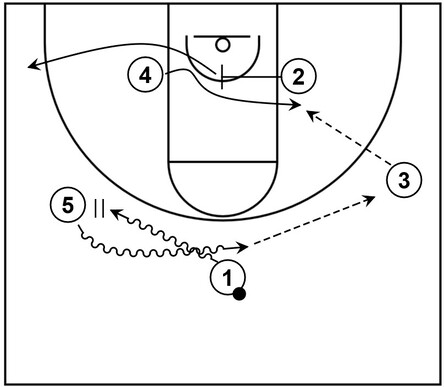
This example features a power forward using a cross screen from a teammate to get open near the low post area.
To start the basic action, 1 dribbles toward the left side wing, represented by the wavy arrow. Next, 1 executes a dribble handoff alongside 5, denoted by the double pipe symbol.
From there, 5 can dribble back toward the top where 1 was initially located.
Following that, 3 receives the ball from 5 and as that occurs, 4 cuts to the right side low post area by way of a cross screen set by 2 who also continues the cut through to the left side corner.
After that, 4 could receive the ball from 3, perform a low post move, and score around the basket.
Down screen
The power forward could set a down screen to help a teammate get open, particularly near a perimeter area of the court such as the wing, the slot, or the top.
Afterwards, the teammate who was freed via the screening action could take a jump shot if feasible or execute another type of action while in possession of the basketball.
What’s more, in certain instances, the power forward would also be able to utilize a down screen to get open as well.
The following diagram showcases a basic example of the down screen.
Example of power forward setting a down screen
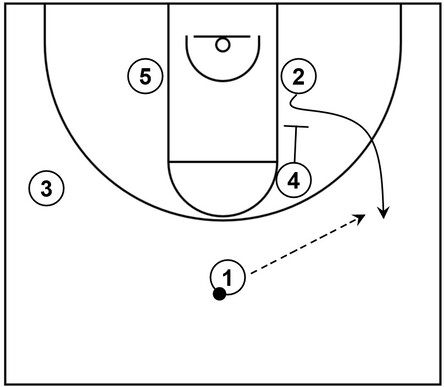
This example features the power forward setting a screen to help another teammate get open near the wing, which could lead to a scoring opportunity.
In terms of the initial setup: 1 is located at the top with possession of the basketball; 2 starts near the right side low post area; 3 fills the left side wing; 4 begins near the right side high post elbow area; 5 occupies the left side low post area.
To start the simple action, 4 basically cuts down toward the adjacent low post area to set a down screen with 2 as the recipient.
From there, 2 uses that screen to get open near the right side wing and receive the ball from 1. Afterwards, 2 could take the three-point shot if open or execute some other offensive action.
Elevator screen
The elevator screen could be set by the power forward, usually alongside the center, to help another offensive player get open near the top behind the three-point line.
Afterwards, the power forward as well as the additional screener could close the gap to block the defender that is covering the third offensive player who utilized the elevator screen.
The following diagram demonstrates an example of the elevator screen action.
Example of power forward setting an elevator screen with a teammate
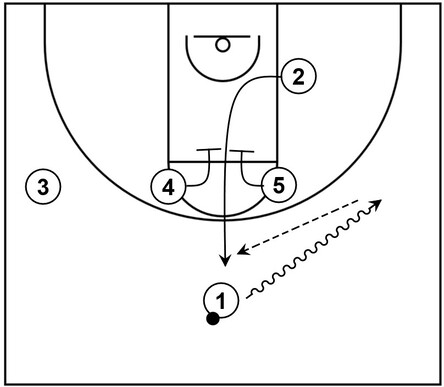
This example features a power forward setting an elevator screen alongside another teammate to ultimately help a third teammate get open for a possible three-point shot.
In terms of the basic setup: 1 is located at the top with possession of the basketball; 2 initially occupies the right side low post area; 3 is on the left side wing; 4 and 5 fill the high post elbow areas.
To begin, 1 executes a dribble entry towards the vacant right side wing. As that occurs, 2 cuts toward the top, particularly between the elevator screen set by 4 and 5.
Afterwards, 2 receives the ball from 1 and could take the open three-point shot.
Flare screen
The flare screen could be set by the power forward for an offensive teammate, who would cut away from the basketball to get open near a perimeter area such as the wing or corner.
The following diagram showcases an example of the flare screen.
Example of power forward setting a flare screen for a teammate
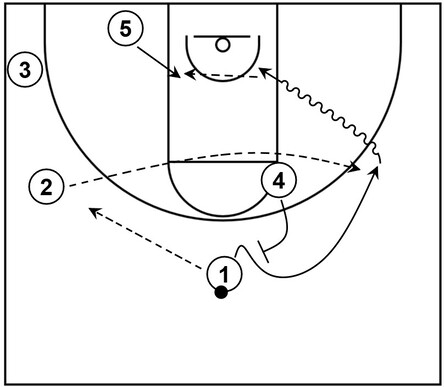
This example comprises a power forward setting a flare screen to help another teammate get open near the wing for a possible three-point shot or dribble penetration opportunity.
In reference to the initial setup: 1 is located at the top with possession of the basketball; 2 occupies the left side wing area; 3 is located in the left side corner; 4 fills the high post; 5 fills the dunker spot near the baseline and short corner.
To start the simple action, 2 receives the ball from 1. Afterwards, 1 cuts to the right side wing via a flare screen set by 4.
3 could throw a skip pass to 1 who could take the shot if open or drive to the basket.
Also, if 1 drives and gets into the paint, then 5 could high dive into the lane from the dunker spot, receive the ball from 1 by way of a shovel pass, and score around the basket.
Flex screen
The flex screen could be set by the power forward in the space between the low post and the adjacent corner to help a teammate get open near the basket.
As a side note, within the flex offense, the power forward could cut to the open slot on the same side via a down screen after setting the initial flex screen, which also happens to be screen the screener action as well.
Furthermore, in certain instances of the flex offense, especially during its continuity, the power forward could potentially receive a flex screen as opposed to only setting it.
The following diagram showcases an example of the flex screen.
Example of power forward setting a flex screen for a teammate
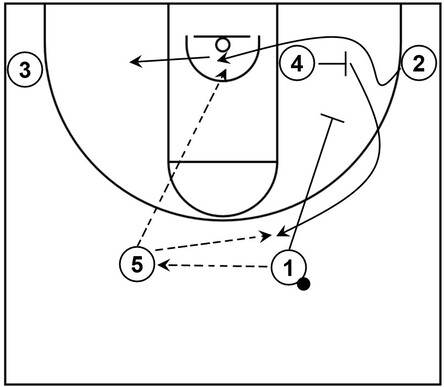
This example consists of a power forward setting a flex screen to help another teammate get open for a potential layup near the basket.
Additionally, the power forward could receive a screen, which could then lead to a possible three-point shot.
In terms of the initial setup: 1 is located in the right slot with possession of the basketball; 2 occupies the right side corner; 3 is located in the left side corner; 4 fills the right side low post area; 5 occupies the left slot area.
To begin the basic action, 5 receives the ball from 1. Next, 2 cuts to the basket by way of the flex screen set by 4.
From there, 2 could receive the ball from 5 and score via a layup. Otherwise, 2 could continue the cut towards the left side low post area.
Moreover, following the flex screen, 4 could use a down screen from 1 and cut towards the right slot area.
4 could receive the ball from 5 and take the open three-point shot if that is feasible.
Floppy action
During floppy action, the power forward could occupy space near one of the low post areas to set a single screen on one side of the lane or a double screen on the other side alongside an additional player such as the small forward or a center.
From there, the single screen or double screen can be ultimately utilized by another another offensive player to get open near the perimeter areas of the court.
The following diagram showcases a simple example of floppy action.
Example of power forward setting a screen as a part of floppy action
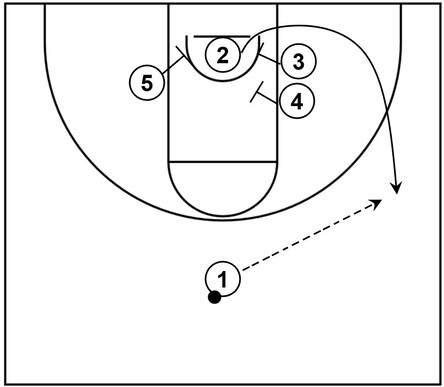
This example features the power forward setting a screen as a part of floppy action to help another teammate get open for a potential layup near the basket.
In terms of the initial setup: 1 is located at the top with possession of the basketball; 2 starts underneath the basket; 3 and 4 are located near the right side low post in a stack; 5 occupies the left side low post.
To begin, 3, 4, and 5 set screens near the lane and 2 has the option to use the single screen of 5 or the double screen of 3 and 4. For this case, 2 utilizes the double screen of 3 and 4. Afterwards, 2 cuts to the right side wing and receives the ball from 1, which could then lead to a three-point shot.
Hammer screen
The hammer screen, a primary element within the hammer set play, could be set by the power forward when a teammate in possession of the ball attacks the baseline on the opposite side of the court.
From there, another teammate could utilize the hammer screen to get open near the adjacent corner, receive the ball via a drift pass, and take the open jump shot.
The following diagram showcases a basic example of the hammer screen.
Example of power forward setting a hammer screen
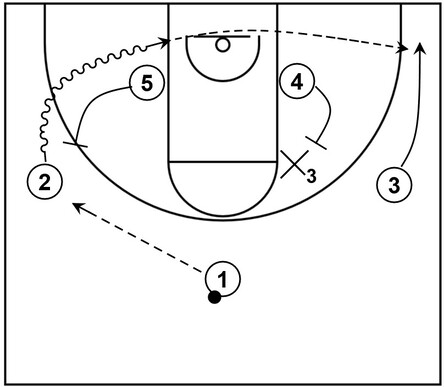
This example features the power forward setting a hammer screen to help another teammate get open near the corner, which could result in a scoring opportunity.
In reference to the initial setup: 1 is located at the top with possession of the basketball; 2 starts near the left side wing area; 3 fills the right side wing; 4 begins near the right side low post area; 5 occupies the left side low post area.
To start the simple action, 2 receives the ball from 1 and afterwards, 5 lifts up from the left side low post area to set a step-up type of screen.
Next, 2 uses that screen and dribbles toward the baseline. While that happens, 4 lifts up from the right side low post area to set a hammer screen on X3, who is the defender guarding against 3 in this example.
Simultaneously, 3 cuts down to the right side corner using the hammer screen in the process, receives the ball via a drift pass from 2, and takes the three-point shot if open.
Inverted on-ball screen
If the power forward has excellent dribbling skills, particularly while in possession of the basketball near the perimeter areas of the court, then it could be possible to utilize an atypical type of on-ball screen.
Specifically, the power forward could use an inverted on-ball screen that would be set by a point guard, shooting guard, or perhaps a small forward.
This particular screening action could be advantageous, especially if the power forward’s defender does not know how to competently fight over the top of an on-ball screen.
The adjacent diagram below demonstrates a simple example of the inverted on-ball screen.
Example of power forward using an inverted on-ball screen
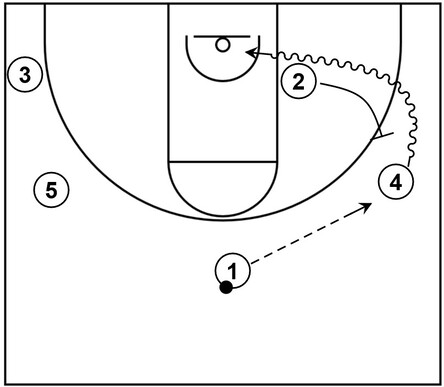
This example features the power forward using an inverted on-ball screen that is set by a teammate, which could lead to a scoring opportunity, preferably close to the basket.
In reference to the initial setup: 1 is located at the top with possession of the basketball; 2 starts near the low post area on the right side; 3 fills the left side corner; 4 and 5 occupy the right side and left side wing areas respectively.
To start the basic action, 4 receives the ball from 1 and after that, 2 lifts from the low post area to set an inverted screen; more specifically, a step-up type of screen.
Next, 4 uses that screen to dribble towards the baseline, ultimately to attack the rim for a potential scoring opportunity via a layup or dunk.
Pick and roll
During pick and roll action, the power forward initially sets an on-ball screen, also known as a pick, for another offensive player, usually a point guard or shooting guard, near the perimeter areas of the court.
Afterwards, the power forward rolls to the basket, receives the ball, and scores near the rim via a layup or dunk.
Alternatively, the power forward could roll to the basket, receive the ball via a lob pass, jump in the air to catch it, and then score via a layup or dunk before touching the ground, which would result in a successful alley-oop.
Generally speaking, the pick and roll is one of the more easier ways that the power forward could score quickly and effectively near the basket.
The adjacent diagram below demonstrates a example of basic pick and roll action involving the power forward.
Example of power forward performing pick and roll action
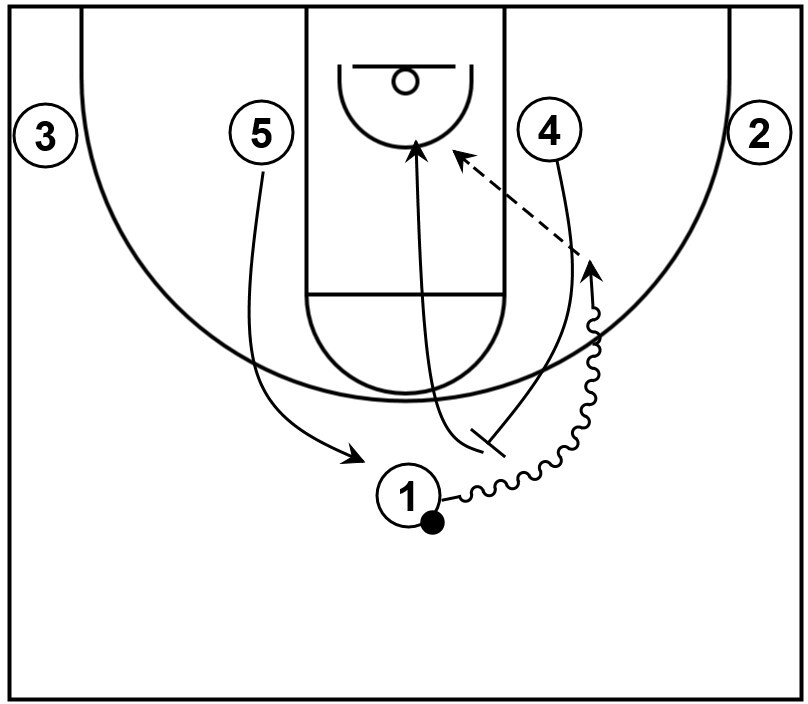
In terms of the initial setup: 1 is at the top in possession of the ball; 2 and 3 occupy the right and left side corners respectively; 4 and 5 fill the right and left side low post areas. This also comprises a 1-4 low alignment as well.
To begin, 4 lifts up towards the top to set a high screen. 1 uses that screen and begins dribbling towards the basket.
As that happens, 4 rolls to the basket while 5 replaces at the top, which is generally called roll and replace action.
Next, 4 could receive the ball from 1 and score via a layup or close-range shot around the basket.
Pick and pop
During pick and pop action, the power forward could set an on-ball screen for a teammate near the perimeter areas of the court.
Following that, however, the power forward could pop to an adjacent empty perimeter area, receive the ball, and take a mid-range or three-point range jump shot if open.
The power forward could consider the pick and pop tactic if the defender that is covering them tries to impede dribble penetration of the player in possession of the ball such as with drop coverage.
The pick and pop action could be potentially useful in that regard because the power forward’s defender would be too far away to effectively contest the possible jump shot.
Additionally, the pop action could be possibly beneficial to a power forward that prefers to play in the style of a stretch four as well.
Screen the screener
In certain cases, the power forward may initially set a screen for a teammate but then receive a screen immediately thereafter, which is generally referred to as screen the screener action.
A primary example of this could be the Spain pick and roll. That is, the power forward could set an on-ball screen, particularly near the top, for a teammate in possession of the basket.
After that, the power forward could begin to roll towards the basket but as that occurs, a third teammate could set a back screen on the defensive player that would be covering the power forward.
That would give the power forward an opportunity to get open, at least momentarily, near the basket. From there, the power forward could receive the ball and score via a layup or dunk.
Transition offense
The power forward could potentially be involved in various actions during transition offense when the team has an opportunity to score, particularly during primary break or secondary break.
Drag screen and roll
During transition offense, the power forward could initially set a drag screen in the frontcourt for a player in possession of the basketball such as the point guard.
Following that, the power forward could then roll to the basket, receive the ball, and score via a layup or dunk.
Drag screen and pop
During transition offense, the power forward could initially set a drag screen in the frontcourt for a player in possession of the basketball such as the point guard.
Afterwards, the power forward could then pop to an open space near a perimeter area such as a slot or wing. From there, the power forward could receive the ball and take an open jump shot for a scoring opportunity.
Rim runner
During transition offense, the power forward could sprint ahead into the frontcourt and run towards the rim before the transition defense is able to react quickly enough.
As an example, let’s say that during the initial phase of transition offense, the center gathers the defensive rebound. However, as that occurs, let’s also say that the power forward is able to quickly sprint into the frontcourt before the defense is able to react.
Afterwards, the center could throw a long distance touchdown pass to the power forward, who could score at the rim with a layup or dunk.
Alternatively, the center could gather the defensive rebound and then execute an outlet pass to the point guard in the backcourt.
From there, the point guard could throw a long distance baseball pass to the power forward, who could receive it and score at the rim via a layup or dunk.
Trailer
During transition offense, the power forward could initially trail behind the ball, sprint to an area such as the slot, receive the ball, and then attempt to score via an open jump shot.
For example, let’s say that during primary break, the point guard has initial possession of the ball in the backcourt but immediately dribbles it into the frontcourt near the right slot area while the power forward trails behind the play.
Next, let’s say that as that occurs, the power forward’s defender initially backpedals towards the nail area to hinder dribble penetration while the power forward sprints into the frontcourt near the left slot.
From there, the point guard could quickly pass the ball to the power forward, who could then take the open jump shot before the power forward’s defender is able to execute a proper defensive closeout.
Additional offensive actions
There are also additional offensive actions that the power forward could utilize or be involved in, which could lead to scoring opportunities.
Low post moves
The power forward could receive the ball near the low post area and then attempt to score points via a series of low post moves such as the jump hook, the drop step, or the post fadeaway jump shot.
The power forward could also receive the ball near the low post area while initially facing away from the basket but then turn towards the basket to take a face-up jump shot as well.
Spot up mid-range shot
The power forward could cut towards certain areas near the perimeter within the three-point line such as the high post area.
Afterwards, the power forward could receive the ball from another offensive player and then take a mid-range jump shot if open.
The spot-up mid-range jump shot is probably one of the more common ways that the power forward could score while being away from the basket.
Spot up three-point shot
The power forward could cut towards certain areas near the perimeter beyond the three-point line such as the top, the slots, the wings, or the corners.
Following that, the power forward could receive the ball during the flow of offensive execution and take three-point jump shots if open.
For example, let’s say that an offensive player in possession of the ball, simply denoted as player A, is near the right side wing area.
At the same time, let’s say that the power forward, simply denoted as player B, fills the left side wing area and there is also an empty adjacent corner.
Afterwards, let’s say that player A successfully dribbles the ball into the gap of the defense towards the middle near the lane.
When that dribble penetration occurs, player B’s defender might slide towards the lane on the weak side to provide help defense.
From that point, the power forward, indicated as player B, could drift to the nearby empty corner, receive the ball from player A via a kick pass, and take the open jump shot.
In this basic scenario, player B’s defender probably would not have enough time to recover and contest the field goal attempt of player B, which could lead to a high quality jump shot.
Free throw
The power forward should be prepared to take and make at least a moderate amount of free throws.
This is especially true near the basket as the power forward would most likely be fouled by one or more defenders in an attempt to prevent high percentage layups or dunks.
Therefore, successfully making free throws is yet another simple method that the power forward could use to score points.
Additional concepts to consider about the power forward
General difference between the power forward and the center
The general difference between the power forward and the center is that the power forward can typically score or defend near the perimeter areas of the court or near the basket while the center usually stays around the rim.
In other words, the power forward is a post-oriented player with supplementary perimeter skills while the center is a post-oriented player that generally emphasizes scoring around the basket and is mainly the team’s best rim protector.
Also, in general, the power forward could be at least a couple of inches shorter than the center and possibly not as strong. However, the power forward will more than likely have a speed and/or quickness advantage over the center.
Furthermore, both of the basketball positions are commonly extraordinary rebounders but the center is most likely better at gathering offensive rebounds because of the potential height advantage and/or possibly greater wingspan in terms of arm length.
General difference between the power forward and the small forward
The general difference between the power forward and the small forward is that the power forward is typically taller plus a better rebounder overall, primarily because of greater arm length.
Also, the power forward is more than likely a better low post defender while the small forward is generally a better perimeter defender, mainly because of speed and quickness.
Additionally, the power forward might not be as accurate from mid-range or three-point range as the small forward but this is not always the case.
For example, the stretch four type of power forward primarily focuses on perimeter scoring and is usually one of the team’s best three-point shooters.
General difference between the power forward and the point guard or shooting guard
The general difference between the power forward and the point guard or shooting guard is that the power forward normally has advantages in terms of height, arm length, as well as strength.
However, the power forward commonly has a disadvantage to the point guard and/or shooting guard in relation to speed and quickness.
Furthermore, the power forward can occupy the low post area and score from there if necessary, which the point guard or shooting guard may not be able to do, particularly on a consistent basis.
Conversely, the point guard or shooting guard mainly scores points and/or generates assists via playmaking abilities near the perimeter areas of the court.
Moreover, with the exception of a stretch four, the power forward might not shoot as accurately from mid-range or three-point range as the point guard or shooting guard.
Nevertheless, the power forward is usually a better scorer around the basket and could finish through contact more consistently than the point guard or shooting guard, primarily due to the advantages of height as well as strength.